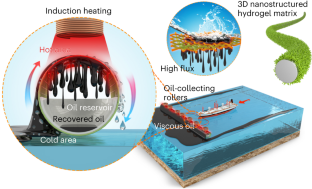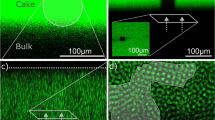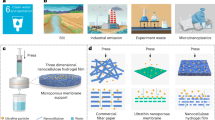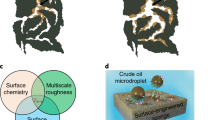Abstract
Crude oil spills, resulting from transportation, drilling or accident, are a severe threat to the aqueous environment. However, crude oil with high viscosity makes the clean-up of oil spills a global challenge in practice because highly viscous oil has low fluidity, making it hard to separate and recover. Here we demonstrate a gel-coated superhydrophobic and oleophilic mesh filter coupled with induction-heating strategy for high-throughput clean-up of viscous oil spill. The direct silane treatment of polyaniline gel with covalent reaction endows the material with robust superwetting properties, which enables the mesh filter to have a high viscous oil separation flux of 2.43 l m−2 s−1. An oil-collecting roller prototype is developed for the recovery of viscous oil spills through the reversibly interfacial process of oil collection and filtration. The continuous clean-up and recovery of viscous oil spills are simultaneously achieved with a high oil recovery rate of up to 1,400.6 kg m−2 h−1 and a separation efficiency of 99%. This work provides a powerful tool for efficient and high-throughput clean-up of highly viscous oil spills, paving the way to better management of the damage from oil spills.
This is a preview of subscription content, access via your institution
Access options
Access Nature and 54 other Nature Portfolio journals
Get Nature+, our best-value online-access subscription
$29.99 / 30 days
cancel any time
Subscribe to this journal
Receive 12 digital issues and online access to articles
$119.00 per year
only $9.92 per issue
Buy this article
- Purchase on Springer Link
- Instant access to full article PDF
Prices may be subject to local taxes which are calculated during checkout





Similar content being viewed by others
Data availability
The authors declare that the data supporting the findings of this study are included within the paper and its Supplementary Information.
References
Brussaard, C. P. et al. Immediate ecotoxicological effects of short-lived oil spills on marine biota. Nat. Commun. 7, 11206 (2016).
White, H. K. et al. Impact of the Deepwater Horizon oil spill on a deep-water coral community in the Gulf of Mexico. Proc. Natl Acad. Sci. USA 109, 20303–20308 (2012).
Jernelov, A. How to defend against future oil spills. Nature 466, 182–183 (2010).
Schrope, M. Oil spill: deep wounds. Nature 472, 152–154 (2011).
Umar, A. A., Saaid, I. B. M., Sulaimon, A. A. & Pilus, R. B. M. A review of petroleum emulsions and recent progress on water-in-crude oil emulsions stabilized by natural surfactants and solids. J. Pet. Sci. Eng. 165, 673–690 (2018).
Prince, R. C., Coolbaugh, T. S. & Parkerton, T. F. Oil dispersants do facilitate biodegradation of spilled oil. Proc. Natl Acad. Sci. USA 113, E1421 (2016).
Rahimi, A. & García, J. M. Chemical recycling of waste plastics for new materials production. Nat. Rev. Chem. 1, 0046 (2017).
Pan, L., Olson, D. H., Ciemnolonski, L. R., Heddy, R. & Li, J. Separation of hydrocarbons with a microporous metal-organic framework. Angew. Chem. Int. Ed. 45, 616–619 (2006).
Wang, D. et al. Design of robust superhydrophobic surfaces. Nature 582, 55–59 (2020).
Zhang, W. et al. Robust superhydrophobicity: mechanisms and strategies. Chem. Soc. Rev. 50, 4031–4061 (2021).
Lively, R. P. & Sholl, D. S. From water to organics in membrane separations. Nat. Mater. 16, 276–279 (2017).
Feng, L. et al. A superhydrophobic and super-oleophilic coating mesh film for the separation of oil and water. Angew. Chem. Int. Ed. 43, 2012–2014 (2004).
Xue, Z. et al. A novel superhydrophilic and underwater superoleophobic hydrogel-coated mesh for oil/water separation. Adv. Mater. 23, 4270–4273 (2011).
Dou, Y. et al. Fish grill inspired crossflow for efficient and continuous collection of spilled oil. ACS Nano 11, 2477–2485 (2017).
Gong, Y. et al. A review of oil, dispersed oil and sediment interactions in the aquatic environment: influence on the fate, transport and remediation of oil spills. Mar. Pollut. Bull. 79, 16–33 (2014).
Song, J. et al. Self-driven one-step oil removal from oil spill on water via selective-wettability steel mesh. ACS Appl. Mater. Interf. 6, 19858–19865 (2014).
Santos, I. C. V. M., Oliveira, P. F. & Mansur, C. R. E. Factors that affect crude oil viscosity and techniques to reduce it: a review. Braz. J. Pet. Gas. 11, 115–130 (2017).
Ge, J. et al. Joule-heated graphene-wrapped sponge enables fast clean-up of viscous crude-oil spill. Nat. Nanotech. 12, 434–440 (2017).
Chang, J. et al. Solar-assisted fast clean-up of heavy oil spills using a photothermal sponge. J. Mater. Chem. A 6, 9192–9199 (2018).
Wu, M. et al. Sunlight induced rapid oil absorption and passive room-temperature release: an effective solution toward heavy oil spill clean-up. Adv. Mater. Interf. 5, 1800412 (2018).
Zhang, C., Wu, M., Wu, B., Yang, J. & Xu, Z. Solar-driven self-heating sponges for highly efficient crude oil spill remediation. J. Mater. Chem. A 6, 8880–8885 (2018).
Kuang, Y. et al. Bioinspired solar-heated carbon absorbent for efficient clean-up of highly viscous crude oil. Adv. Funct. Mater. 29, 1900162 (2019).
Li, Q. et al. Solar-heating Crassula perforata-structured superoleophilic CuO@CuS/PDMS nanowire arrays on copper foam for fast remediation of viscous crude oil spill. Adv. Mater. Interf. 12, 19476–19482 (2020).
Wu, S. et al. Spill-SOS: self-pumping siphon-capillary oil recovery. ACS Nano 13, 13027–13036 (2019).
Bera, A. & Babadagli, T. Status of electromagnetic heating for enhanced heavy oil/bitumen recovery and future prospects: a review. Appl. Energy 151, 206–226 (2015).
Hasan, S. W., Ghannam, M. T. & Esmail, N. Heavy crude oil viscosity reduction and rheology for pipeline transportation. Fuel 89, 1095–1100 (2010).
Kota, A. K., Kwon, G., Choi, W., Mabry, J. M. & Tuteja, A. Hygro-responsive membranes for effective oil–water separation. Nat. Commun. 3, 1025 (2012).
Si, Y. et al. Superelastic and superhydrophobic nanofiber-assembled cellular aerogels for effective separation of oil/water emulsions. ACS Nano 9, 3791–3799 (2015).
Ryan, M. P., Williams, D. E., Chater, R. J., Hutton, B. M. & McPhail, D. S. Why stainless steel corrodes. Nature 415, 770–774 (2002).
Xing, C., Zhang, Z., Yu, L., Waterhouse, G. I. N. & Zhang, L. Anti-corrosion performance of nanostructured poly(aniline-co-metanilic acid) on carbon steel. Prog. Org. Coat. 77, 354–360 (2014).
Deshpande, P. P., Jadhav, N. G., Gelling, V. J. & Sazou, D. Conducting polymers for corrosion protection: a review. J. Coat. Technol. Res. 11, 473–494 (2014).
Cui, M. et al. Influence of water adhesion of superhydrophobic surfaces on their anti-corrosive behavior. Surf. Coat. Technol. 347, 38–45 (2018).
Oksenvag, J. H. C., Fossen, M. & Farooq, U. Study on how oil type and weathering of crude oils affect interaction with sea ice and polyethylene skimmer material. Mar. Pollut. Bull. 145, 306–315 (2019).
Ge, J. et al. Advanced sorbents for oil-spill clean-up: recent advances and future perspectives. Adv. Mater. 28, 10459–10490 (2016).
Ge, J. et al. Pumping through porous hydrophobic/oleophilic materials: an alternative technology for oil spill remediation. Angew. Chem. Int. Ed. 126, 3686–3690 (2014).
Wang, Y., Shang, B., Hu, X., Peng, B. & Deng, Z. Temperature control of mussel-inspired chemistry toward hierarchical superhydrophobic surfaces for oil/water separation. Adv. Mater. Interf. 4, 1600727 (2017).
Acknowledgements
G.Y. acknowledges financial support from Welch Foundation F-1861, Norman Hackerman Award in Chemical Research and Camille Dreyfus Teacher-Scholar Award. L.P. and Y.S. acknowledge the support of the Natural Science Foundation of China under grant nos. 61825403 and 61921005 and National Key Research and Development Program of China under grant no. 2021 YFA1401103. We would also like to thank K. Mohanty at the Department of Petroleum and Geosystems Engineering, University of Texas at Austin, for providing crude oil.
Author information
Authors and Affiliations
Contributions
G.Y., L.P. and Y.S. supervised the project. K.Y., F.Z., L.P. and G.Y. conceived and designed the experiments. K.Y., F.Z. and Y.J. performed the experiments. K.Y., L.P., Y.S. and G.Y. co-wrote the paper. All authors discussed the results and commented on the manuscript.
Corresponding authors
Ethics declarations
Competing interests
The authors declare no competing interests.
Peer review
Peer review information
Nature Sustainability thanks Jianmei Lu, Paul Braun and the other, anonymous, reviewer(s) for their contribution to the peer review of this work.
Additional information
Publisher’s note Springer Nature remains neutral with regard to jurisdictional claims in published maps and institutional affiliations.
Supplementary information
Supplementary Information
Supplementary Methods, Figs. 1–25 and Tables 1–5.
Supplementary Video 1
Superhydrophobic and oleophilic properties of the GSSM.
Supplementary Video 2
Simulation of the gravity-driven separation process of the water-in-oil emulsion by the GSSM.
Supplementary Video 3
Simulation of the dynamic oil penetration process through the GSSM with different heating temperatures.
Supplementary Video 4
Continuous oil clean-up and recovery process by the oil-collecting prototype device.
Supplementary Video 5
The temperature gradient of the induction-heated GSSM roller in the working process by thermal imaging.
Rights and permissions
Springer Nature or its licensor (e.g. a society or other partner) holds exclusive rights to this article under a publishing agreement with the author(s) or other rightsholder(s); author self-archiving of the accepted manuscript version of this article is solely governed by the terms of such publishing agreement and applicable law.
About this article
Cite this article
Yan, K., Zhao, F., Pan, L. et al. High-throughput clean-up of viscous oil spills enabled by a gel-coated mesh filter. Nat Sustain 6, 1654–1662 (2023). https://doi.org/10.1038/s41893-023-01217-2
Received:
Accepted:
Published:
Issue Date:
DOI: https://doi.org/10.1038/s41893-023-01217-2
This article is cited by
-
Solar-heated melamine sponge decorated with Fe3O4 for continuous recovery of viscous crude oil
Journal of Porous Materials (2024)
-
Cleaning up oil spills
Nature Reviews Materials (2023)



